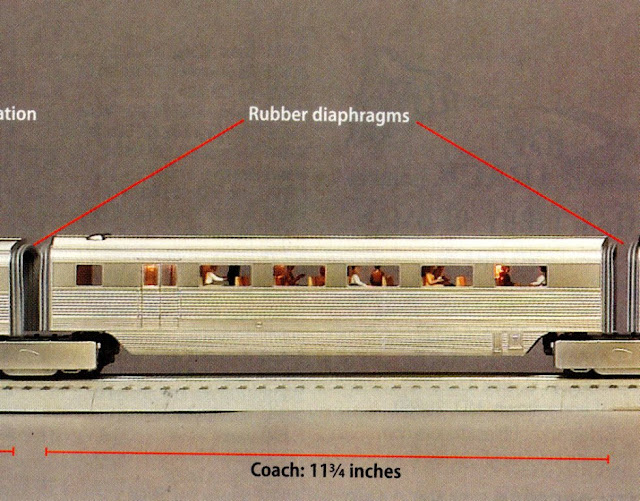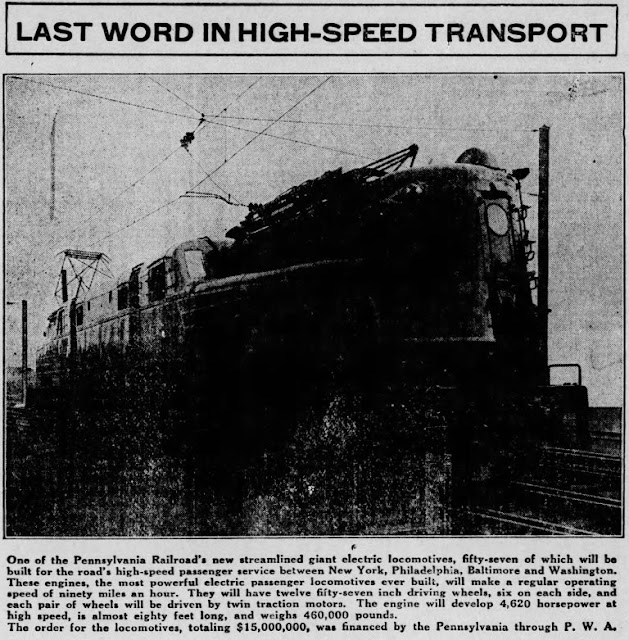
Above: "Refugees," a lithograph by Joseph Leboit (1907-2002), created while he was in the WPA, ca. 1935-1943. Image courtesy of the Smithsonian American Art Museum.
Periodic posts about the most interesting time in American history: The New Deal!
Monday, March 28, 2022
New Deal Art: "Refugees"
Sunday, March 20, 2022
PWA assistance to our nation's railroads: How massive was it?
Above: Part of a larger story from the Knoxville Journal (Knoxville, Tennessee), July 22, 1934, p. 3. Image from newspapers.com, used here for educational and non-commercial purposes.
PWA money for railroad repairs, construction, modernization, and employment
During the New Deal, the Public Works Administration (PWA) loaned $200 million to 32 American railroad companies. That's about $4.1 billion in 2021 dollars.
These New Deal funds created the following:
* 195 new locomotives, and another 1,928 locomotives repaired.
* 11 new and complete streamline trains (i.e., locomotive + articulated passenger cars; see, e.g., the Flying Yankee).
* 303 new passenger cars, and another 947 cars repaired.
* 24,170 new freight cars, and another 40,877 cars repaired.
* New or improved track beds, railroad bridges, and railway structures.
* Tens of thousands of tons of rail.
* Electrification of the Pennsylvania Railroad's New York to DC passenger route.
* Elimination of dangerous grade crossings (grade crossings are where train track and automobile roadway intersect at the same level - thus creating an accident hazard).
* 100,000 railroad workers back on the job.
* Improved railroad earnings (after several dismal years).
* 100 industries other than railroads benefited.
* A financial return for the government, i.e., "We the People" (for example, through the sale of bonds as collateral against the loans).
(Main sources of information: (a) "PWA Aided By Gain On Rails," Scripps-Howard Newspaper Alliance, in The Oklahoma News (Oklahoma City, Oklahoma), November 22, 1936, p. 4; (b) C.W. Short and R. Stanley-Brown, Public Buildings: A Survey of Architecture of Projects Constructed by Federal and Other Governmental Bodies, Between the Years 1933 and 1939, With the Assistance of the Public Works Administration,Washington, DC: U.S. Government Printing Office, 1939, p. 653; (c) Public Works Administration, America Builds: The Record of PWA, Washington, DC: U.S. Government Printing Office, 1939, pp. 188-189; (d) Federal Emergency Administration of Public Works, The Story of PWA in Pictures, Washington, DC: U.S. Government Printing Office, 1936.)
"The railroad construction and improvement program is one of the brightest chapters in the history of PWA. It is a complete demonstration of the theory of public works as a recovery measure."
--Harold Ickes, PWA Administrator and U.S. Secretary of the Interior, Associated Press article, in "Sale of PWA Securities," Lincoln Journal Star (Lincoln, Nebraska), February 14, 1936, p. 1.
Monday, March 14, 2022
The New Deal's "Old Rivets" Locomotive - Pennsylvania Railroad 4800
Above: The locomotive in the foreground is Pennsylvania Railroad 4800 or, as it came to be known over the decades, "Old Rivets." It's an electric train, shown here beside an older steam-style train. It's called "Old Rivets" because it was the first of its kind, its body was put together with rivets, and all of the subsequent locomotives of this class (GG-1) utilized welding instead of rivets. During the New Deal, somewhere between 57 and 101 of these locomotives were built with loans from the New Deal's Public Works Administration (PWA). Each one cost about $250,000 (about $5.2 million in 2021 dollars). Photo courtesy of the National Archives.
Above: The description for this photograph, showing "Old Rivets" ca. 1935, reads: "A new high speed electric locomotive ready to start its run between Washington and New York. PWA funds financed the purchase of this train." As you can see from the work sign in the photo above, "Old Rivets" and its offspring were part of a larger effort to modernize and electrify America's railways. In its 1939 report, America Builds: The Record of PWA, the Public Works Administration notes: "Total loans to the Pennsylvania Railroad amounted to $70,165,000 [about $1.5 billion in 2021 dollars] for completing electrification of its New York to Washington division, building 68 electric locomotives, and 7,000 new freight cars, and purchasing 33 electric locomotives and 97,787 tons of rail" (p. 189, footnote 2, emphasis added). Not all of the 101 locomotives noted in this statement were necessarily of the "Old Rivets" model, and other sources suggest that about 57 "Old Rivets" style locomotives were built (see next photo and caption). Photo courtesy of the National Archives.
Above: The caption for this photo--which comes from The Perry County Democrat (Bloomfield, Pennsylvania), November 28, 1934-- notes that the 57, PWA-financed, "Old Rivets" style locomotives were, at the time, "the most powerful electric passenger locomotives ever built." Further, an earlier article in The Gazette (Cedar Rapids, Iowa) reported that PWA loans allowed the Pennsylvania Railroad to make "one of the largest equipment orders in the history of American railroading" (November 10, 1934, p. 1). And all of this financing and ordering allowed thousands of railroad workers to return to their jobs, and would benefit about 100 other industries (see, e.g., "Huge Electrification Program of P.R.R. in Full Swing," The News-Herald (Franklin, Pennsylvania), March 28, 1934, p. 1). Photo from newspapers.com, used here for educational and non-commercial purposes.
Above: A timetable brochure for the Pennsylvania Railroad, from April 24, 1938. The locomotive shown on this brochure is one of the PWA-financed GG-1 locomotives (but not "Old Rivets"). Image scanned from a personal copy.

Above: In the timetable brochure, the Pennsylvania Railroad boasts its New Deal-facilitated, "All-Electric Mileage." Image scanned from a personal copy.

Above: A postcard showing "Old Rivets" in 1976. The back of the postcard reads, "Bicentennial colors on Conrail [formerly Pennsylvania Railroad] 4800 add another milestone to this famous electric locomotive. No. 4800 was the first GG1, built in 1934, and the only one with a riveted carbody. It is also the first locomotive to wear the Conrail name. Shown at Harrisburg, Pa., April 12, 1976." Photo by James P. Shuman, postcard by Audio Visual Designs (Earlton, New York), used here for educational and non-commercial purposes.

Above: A postage stamp of "Old Rivets." According to the Wikipedia entry for "Old Rivets," the locomotive "was designated a Historic Mechanical Engineering Landmark by the American Society of Mechanical Engineers (ASME) on April 23, 1983," and "In 2012, PRR 4800 was inducted into the North America Railway Hall of Fame for its contribution to the railway industry." Image above scanned from a personal copy.

Above: "Old Rivets," at the Railroad Museum of Pennsylvania (RMP). According to RMP, "The much talked about GG-1 was the result of a desire to have a reliable, fast, powerful, and numerous other requirements all in one electric locomotive package. In the end the final product proved to be better than anyone including [the Pennsylvania Railroad] could have hoped for... GG-1’s as a locomotive class were the longest serving of any locomotive class whether it be steam, electric, or diesel in the U.S. and abroad." RMP notes that "Old Rivets" ran "until almost 1980," i.e., nearly half-a-century. Photo from the website of the Railroad Museum of Pennsylvania, accessed March 14, 2022, and used here for educational and non-commercial purposes.
Sunday, March 6, 2022
The New Deal's Flying Yankee Train

Above: A view of the Flying Yankee, from the back "Observation Lounge" to the front. The description for this photograph reads, "The Flying Yankee, one of New England's crack streamliners. PWA funds financed the purchase of this train." In the 1939 report, America Builds: The Record of PWA, it's noted that "On many another railroad, the Diesel-powered, lightweight streamlined trains, such as the Rebel of the Gulf, Mobile & Northern Railroad in the South, and the Flying Yankee in New England, that daily flash thousands of people from city to city, are the results of PWA loans" (p. 189). Photo courtesy of the National Archives.

Above: From the Spring Lake Gazette (Spring Lake, New Jersey), February 21, 1935, p. 2. The author of the article, Lattimer Shaw, wrote: "the new silvery flyer easily and safely has attained a speed of more than 100 miles an hour... the 'Yankee's' 35 cents a mile forecasting enormous savings over the 65 to 80 cents a mile for steam train operation... The 'Flying Yankee' is proclaimed by railroad experts and automotive men as a forerunner of great fleets of similar trains which are expected to appear in the next few years to change completely the already romantic picture of American railroading and, in fact, human transportation itself." Unknown photographer, provided courtesy of newspapers.com, and used here for educational and non-commercial purposes.

Above: The coach section of the MTH Flying Yankee model train set. Keller writes on the actual PWA-funded Flying Yankee train, "the experimental streamliners were constructed of stainless steel and were much lighter than a conventional train. The silver color suggested something ultra-modern, such as commercial airliners. Creature comforts were high on the agenda, with air-conditioned cars and a quieter traveling experience through cork insulation, indirect lighting, and better cushioned seats" (see previously cited Classic Toy Trains magazine). Image above scanned from a personal copy, and used here for educational and non-commercial purposes.

Above: The box of a Flying Yankee wind-up toy. On another side of the box, we learn: "When the silver train arrived in Boston in 1935, large crowds gathered to see the latest in technology. Built for the Boston & Maine and Maine Central Railroads, the Flying Yankee brought excitement and optimism to a region still in the grips of the Great Depression until it was retired in 1957. Now owned by the State of New Hampshire, the Flying Yankee is being restored. When complete, it will be the only train of this type to ever operate again. For more information, visit www.flyingyankee.com. This is a very special train to collectors and its smooth shiny shape appeals to everyone. Chrome plated." Photo by Brent McKee.
Above: A 2021 video by Keith Totten, showing an older Lionel Flying Yankee train set in action. YouTube link: https://www.youtube.com/watch?v=q_jajuL3QiA.
Above: A 2009 video highlighting the history and recollections of the Flying Yankee, as well as modern restoration efforts. Today, the Flying Yankee is located at the Hobo Railroad in Lincoln, New Hampshire, but restoration efforts seem to have stalled, probably due to a lack of funding. YouTube link: https://www.youtube.com/watch?v=muH7bSf5lo8.








